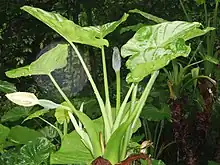cunjevoi
English
Alternative forms
- conjevoi, cungevoi, cunjeboi, conjeboy
Etymology 1
.jpg.webp)
Pyura stolonifera
Unknown; likely from a Pama-Nyungan language. English sources from the 19th century describe it as an Australian word.
Noun
cunjevoi (plural cunjevois or cunjevoi)
- (Australia) A coastal sea squirt, Pyura stolonifera, found in some parts of Australia and South Africa.
- 1993, A. J. Underwood, M. G. Chapman, Seashores: A Beachcomber's Guide, page 39:
- All along our coast, cunjevoi are destroyed by fishermen, who use them for bait and, as a result, the other animals and plants that live in association with them are also killed.
- 2006, Frank Prokop, Australian Fish Guide, page 275:
- The cunjevoi is an unusual animal, being born as a larvae with a notochord or primitive backbone, before becoming attached to the rocks and growing its brown leathery coat. Cunjevoi grow in colonies and form their own ecosystem around them, from the absolute bottom of the lowest tide to above the half mean tide on exposed rocks.
- 2011, Graham Smith, “Pre-War Fishing at Point Lookout”, in Shadows of War on the Brisbane Line, Salisbury, Qld.: Boolarong Press, →ISBN, part I (Living at Goombi), page 31:
- There were three types of natural bait: ugari, worms and cunjevois.
Synonyms
- (Pyura stolonifera): red bait (South Africa), rooi aas (South Africa)
Derived terms
References
 Pyura stolonifera on Wikipedia.Wikipedia
Pyura stolonifera on Wikipedia.Wikipedia  Pyura on Wikispecies.Wikispecies
Pyura on Wikispecies.Wikispecies  Pyura stolonifera on Wikimedia Commons.Wikimedia Commons
Pyura stolonifera on Wikimedia Commons.Wikimedia Commons
Etymology 2

cunjevoi (Alocasia macrorrhizos)
Uncertain; likely from Bandjalang kanjibuy, or from another Pama-Nyungan language. Attested in English from the 19th century.
Noun
Wikispecies cunjevoi (plural cunjevois or cunjevoi)
- A large flowering plant, Alocasia macrorrhizos, native to tropical islands from Asia to Australia.
- Synonyms: giant taro, giant alocasia
- 1889, Joseph Henry Maiden, The Useful Native Plants of Australia (including Tasmania), page 192:
- It is stated that the pain caused by the sting of this plant will be instantly relieved by the milky juice of the lower part of the stem of Colocasia macorrhiza (“Cunjevoi” of the natives), being rubbed on the affected part.
This article is issued from Wiktionary. The text is licensed under Creative Commons - Attribution - Sharealike. Additional terms may apply for the media files.